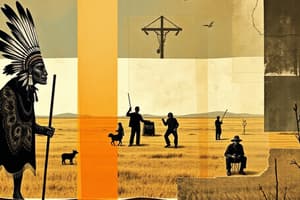Podcast
Questions and Answers
What is the primary reason for the high rate of type 2 diabetes among the Tohono O'odham tribe?
What is the primary reason for the high rate of type 2 diabetes among the Tohono O'odham tribe?
- Limited access to fresh produce
- Historical water diversion
- Colonization and social circumstances (correct)
- Genetic predisposition
Why did the historically self-sufficient Tohono O'odham tribe see a change in their health status over time?
Why did the historically self-sufficient Tohono O'odham tribe see a change in their health status over time?
- Emphasis on physical activity
- Increased genetic mutations
- Introduction of unhealthy commodity foods (correct)
- Adoption of modern medical practices
What factor plays a significant role in impacting blood sugar control among populations facing high rates of diabetes?
What factor plays a significant role in impacting blood sugar control among populations facing high rates of diabetes?
- Cultural traditions
- Climate change
- Physical exercise
- Stress hormones (correct)
What is highlighted as a common risk factor for diabetes among various populations worldwide?
What is highlighted as a common risk factor for diabetes among various populations worldwide?
Why do both the Tohono O'odham and Pima tribes face challenges related to type 2 diabetes despite their historical differences?
Why do both the Tohono O'odham and Pima tribes face challenges related to type 2 diabetes despite their historical differences?
How have historical societal changes affected the health outcomes of Native American tribes like the Tohono O'odham?
How have historical societal changes affected the health outcomes of Native American tribes like the Tohono O'odham?
Which factor contributes significantly to the diabetes epidemic among Native American communities?
Which factor contributes significantly to the diabetes epidemic among Native American communities?
What has hindered research aimed at understanding the cause of diabetes among the Pima tribe?
What has hindered research aimed at understanding the cause of diabetes among the Pima tribe?
'Hopefulness' is mentioned as playing a role in managing diabetes. What other factor significantly impacts health outcomes according to the text?
'Hopefulness' is mentioned as playing a role in managing diabetes. What other factor significantly impacts health outcomes according to the text?
'Master water engineers' from the Pima tribe transformed the desert into farmland historically. Why does this tribe face a high rate of type 2 diabetes according to the text?
'Master water engineers' from the Pima tribe transformed the desert into farmland historically. Why does this tribe face a high rate of type 2 diabetes according to the text?
Flashcards are hidden until you start studying
Study Notes
- Terell du Johnson, a member of the Tona aam American Indian tribe, is an artist and activist from a reservation south of Phoenix, Arizona.
- The Tona aam tribe has the highest rate of type 2 diabetes globally, with half of the adults affected.
- The tribe historically lived self-sufficiently on local crops and game, which kept them healthy, but their way of life has changed.
- The Puma tribe on the Hila River Reservation also faces a high rate of type 2 diabetes, despite their ancestors being master water engineers who transformed the desert into farmland.
- Research on diabetes among the Puma has not led to a cure or understanding of its cause, with genetics being a complex factor.
- Various populations worldwide, such as Pacific Islanders and African-Americans, have high rates of type 2 diabetes linked to historical dispossession and social circumstances.
- Poverty is a significant risk factor for diabetes, with stress hormones impacting blood sugar control.
- The impact of colonization, water diversion, and poverty on Native American health, specifically diabetes rates, is highlighted.
- The availability of unhealthy commodity foods, lack of access to fresh produce, and limited resources contribute to the diabetes epidemic among Native American communities.
- Hopefulness plays a role in managing diabetes, but social determinants like poverty, lack of healthy food options, and limited access to resources significantly impact health outcomes.
- Efforts to regain water rights, rebuild communities, and focus on prevention rather than just treatment are crucial steps towards addressing the diabetes epidemic in Native American populations.
Studying That Suits You
Use AI to generate personalized quizzes and flashcards to suit your learning preferences.




